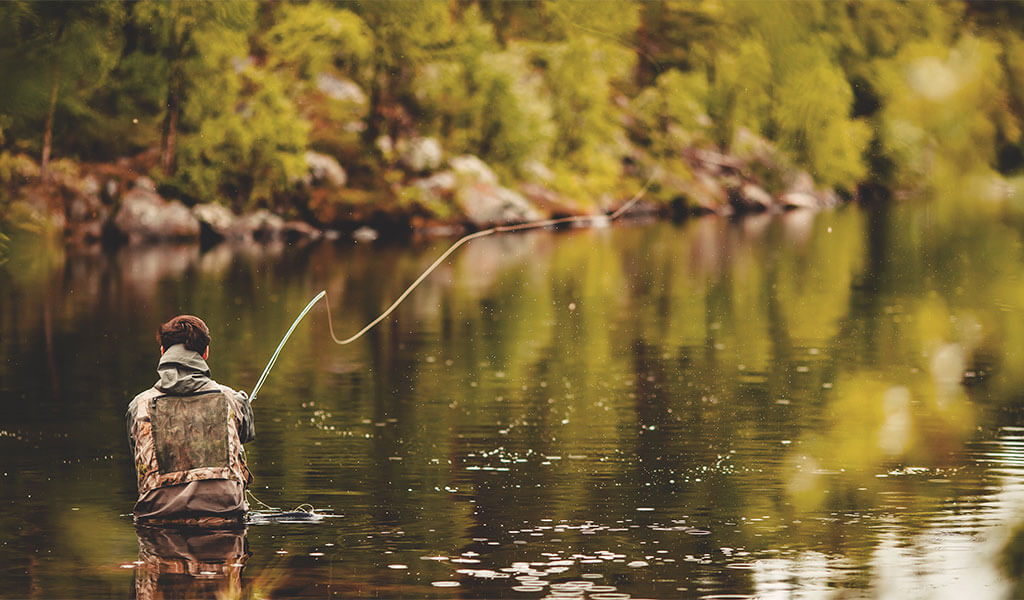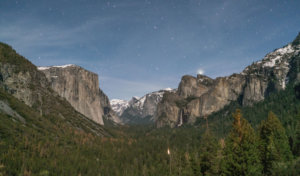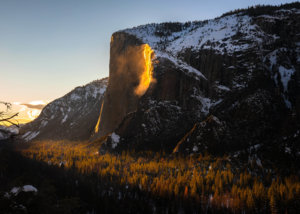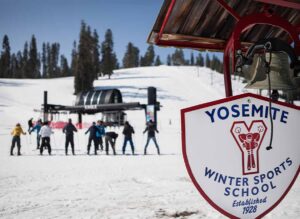Okay, we’ll try to rein in the puns about how it’s easy to get hooked, or quips about keeping it reel, but fishing in Yosemite Mariposa is indeed recognized as having just the right amount of too many trout. With pristine lakes (both high and low country), National Forest streams and the mighty Merced River weaving through Yosemite Valley before plunging down the steep Sierra Foothills, fishing in Mariposa County provides a unique array of breathtaking backdrops for flicking a line.
Whether fly fishing, bait fishing or catch & release, anglers can enjoy ample amenities from minimalist camping to world-class resorts, from solo forest forays to guided backcountry excursions and foodie haunts to hand-crafted brewpubs where fish stories bounce off the rafters. Want to drop a lure from shore? Check. Bring your boat? Yep. Just want to meditate hip-wader deep in some of the purest water in the country? Now we’re talking. Whatever your lean, one thing’s for certain “” Yosemite Mariposa is oFISHally (sorry, couldn’t resist!) a trip worth making.
Fishing and Fly Fishing in Yosemite National Park

Yosemite National Park is the crown jewel of Mariposa County. Covering 1,169 square miles and with elevations ranging from 3,000 feet to 13,000 feet in the High Sierra, the water features runneth over creating a fishing mecca the size of Rhode Island and Luxembourg where anglers can cast to their heart’s content.
Fly fishing in Yosemite’s beautiful waters offers multiple locations for an unforgettable fishing adventure, so grab your fly rod and wade out! Who knows, you might even catch one of the rare and prestigious golden trout.
Yosemite Valley
Yosemite Valley is all about trout and the magical meander of the Merced River. You’ll have lots of company here, but relatively few of the sightseers will be fishing and the backdrop of iconic granite cliffs is tough to beat. The season opens the last Saturday in April and runs to November 15.
Due to the Park’s protected status, all rainbow trout are catch & release only and only artificial lures/flies with barbless hooks can be used (no bait fishing). Brown trout have a limit of 5 per day or 10 in possession. A good time to fish Yosemite Valley is after peak snow runoff in June and early July, but results can be had in late spring and fall as well. Check out the current conditions of the Merced River (height/temperature/discharge) using the USGS gauge at Happy Isles.
Fishing In Mariposa County’s High Country Lakes & Streams
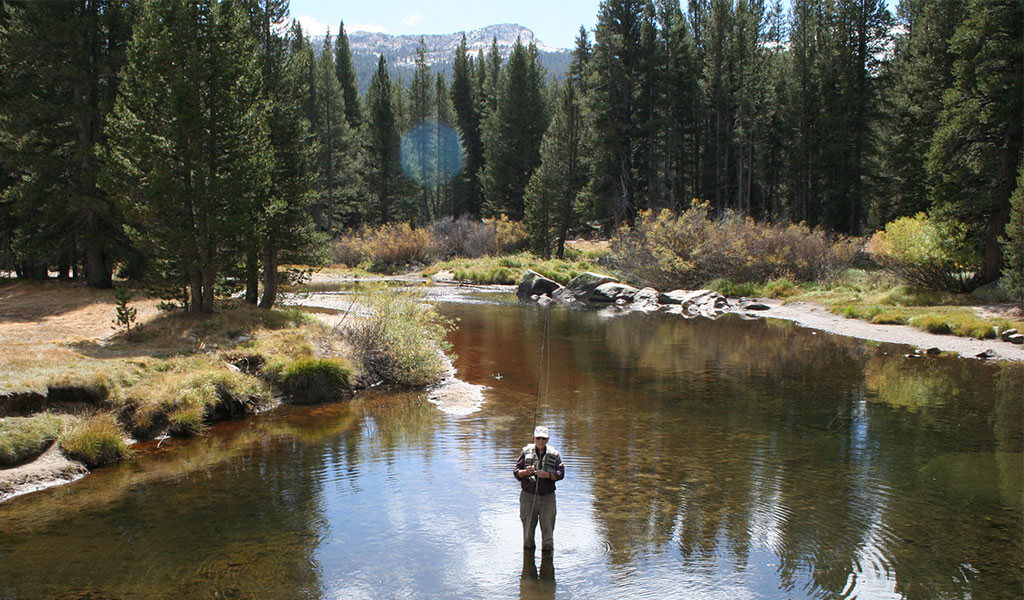
With over 3,200 lakes and 1,700 miles of streams in Yosemite National Park, those found in the High Country are indeed the most pristine. Some can be easily accessed by car along Tioga Road, while others require hiking/backpacking from any number of Yosemite’s trailheads. Trout are the name of the game here, and fishing destinations within striking distance of Tioga Road include Tenaya Lake, Dog Lake, Lukens Lake and Tuolumne Meadows.Tenaya Lake fishing is accessible by car and is known for abundant brook trout.
The backcountry streams and lakes are as numerous as the stars in the Sierra sky, and though they are more difficult to reach the reward of getting off the beaten path far out-casts the effort.
Fishing in the Tuolumne River has different regulations than fishing in Yosemite Valley. Catch and release is not required for fish under 12 inches in length, but anything over 12 inches must be released. The trout limit is two-per-day. The Tuolumne river fishing is perfect for bait-fishing and fly fishing aficionados alike. You’ll find brown trout, brook trout and rainbow trout in both the Dana Fork and the Lyell Fork.
Wawona/Yosemite South
Fishing the Wawona/Yosemite South area brings anglers to the less-visited but equally babbling South Fork of the Merced River. Originating at 10,600 feet on the flanks of Triple Divide Peak, the South Fork plunges into Wawona Valley (elevation 4,000 feet) where it meets Chilnualna Creek and levels off, forming pools suitable for trout angling and swimming alike. Need a cold beer and snack once the fish stop biting? Try relaxing in an Adirondack chair on the lawn of the historic Wawona Hotel.
Fishing The Merced River Canyon (Outside Yosemite National Park)
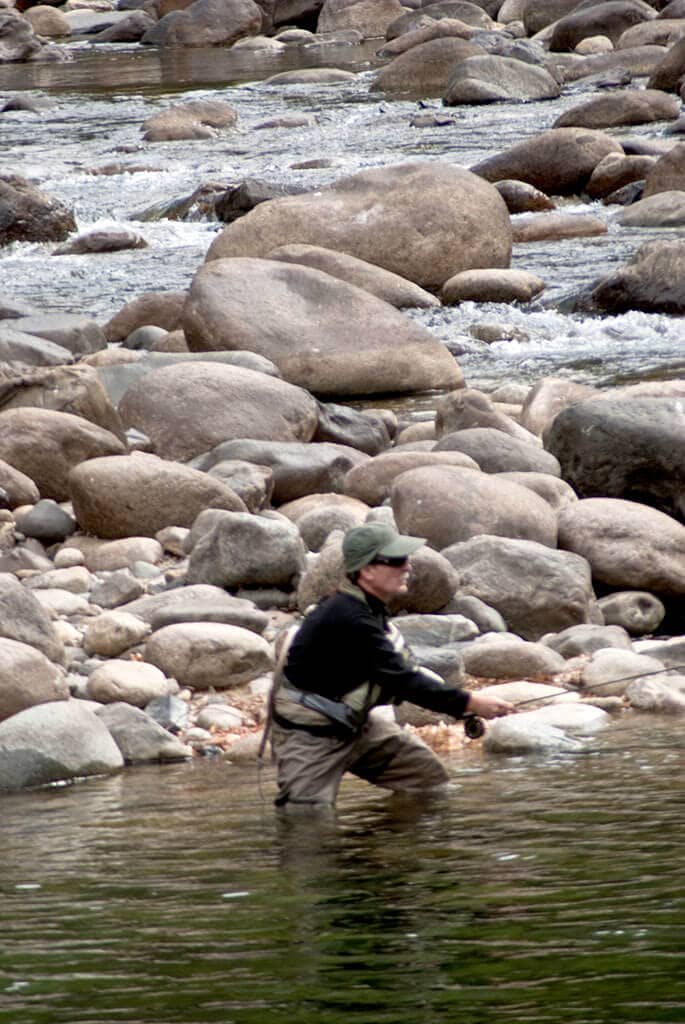
With its National Wild & Scenic River designation, the Merced continues flowing outside Yosemite as it follows all-season Highway 140. The rugged beauty of this stretch of river canyon creates the perfect amphitheater for angling with its boulder-dappled pools, deep pockets, steep walls and alternating sections of shallow riffles. The character of the Merced River changes from season to season, bustling with cold whitewater runoff in spring then warming pools under overhanging banks, shallows and deep pools and slowing come fall. Elevation also plays a part, with the Merced situated just shy of 2,000 feet in El Portal and dropping to just over 800 feet where it feeds Lake McClure.
Boundary of Yosemite National Park to Foresta Bridge
The Merced River is divided into two segments when it comes to regulations. The first segment starts at Yosemite National Park’s boundary at the Arch Rock Entrance (4 miles east of El Portal) and runs to the Foresta Bridge (Red Bud Picnic Area). Here, the fishing season is open year-round using only artificial lures with barbless hooks & flies (no bait fishing). Rainbow trout are strictly catch & release while the limit on brown trout is 5 per day, with a possession limit of 10.
Foresta Bridge to Lake McClure
The second segment, Foresta Bridge to Lake McClure, is open year-round but divided into two mini-seasons. From the last Saturday in April through November 15 (bait & barbs are allowed) with a limit of 5 trout per day and 10 trout in possession, while the remainder of the year the day and possession limit is 2 trout. Warmer water at lower elevations brings the occasional smallmouth bass, and the spectacular spring wildflower hike along the Hite Cove Trail starts along Highway 140 where the South Fork of the Merced River meets the Main Fork.
Those in search of trout hideouts can park along Highway 140 in the small lots of day-use picnic areas such as Red Bud, Cranberry Flat, Indian Flat, McClendon Beach and Briceburg Put-In, or numerous turnouts along the way (careful to pull completely off the road). Following Briceburg Road as it spurs off Highway 140 brings anglers to campgrounds such as McCabe Flat, Willow Placer and Railroad Flat. In this warmer section of the river, trail fishing on foot is the name of the game while flicking a line where the Merced River flows into Lake McClure can be accessed via the Bagby Recreation Area along historic Highway 49.
Fishing Mariposa County Streams
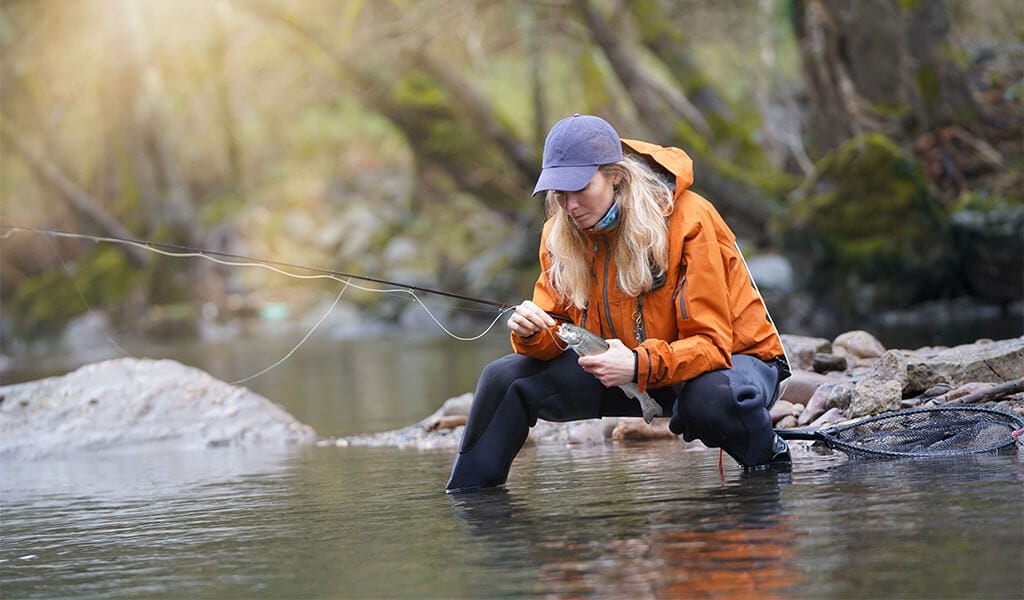
The streams of Mariposa County are primarily located in the Stanislaus and Sierra National Forests. This is rugged country and possesses its own beauty from pine-smothered sections to hotter, more austere, foothills. Most of these streams are small and require stealth and patience to sneak up on fish with short casts or drops into shady pools.
Fishing in Sierra National Forest
A popular spot for trouting in the Sierra National Forest is Big Creek. Located just outside the boundary of Yosemite near the aptly-named town of Fish Camp, Big Creek features rocky granite pools and riffles that stay cool in summer with an elevation of 5,000 feet. Summerdale Campground “” nestled in a Sierra meadow surrounded by fir, cottonwood and cedar “” provides a nice hub for exploration, including the nearby Mariposa Grove of Giant Sequoias. The stream fishing season in Sierra National Forest runs the last weekend of April through November 15. You will find beaver dams and long shallow areas below the Summerdale Campground that are great for dry and wet fly fishing and surprisingly, many crawdads that can be fished for a tasty appetizer. Jackson Road from Fish Camp will take you further to the north east accessing fishing areas of areas of Big Sandy and Little Sandy. These require a four-wheel drive and a bit more time to access.
Fishing in Stanislaus National Forest
Accessed by numbered Forest Service roads, these streams are off-the-beaten-path at elevations ranging from 2,000 feet to 3,500 feet and require a reliable vehicle not to mention food & water. This area is the original route walked by John Muir and is rich in Sierra history.
Bull Creek is a remote and steep section of water surrounded by mixed forest that is best accessed from the uber-historic Gold Rush town of Coulterville. The drive is approximately 25 miles and takes about an hour up to Anderson Flat (3,300 feet) where Forest Route 2S02 follows Bull Creek for 5 miles. The water gets low and warm late in the season, so spring/early summer is best. Dispersed (primitive) camping is allowed in Stanislaus National Forest.
Again using Coulterville as your starting point, Bean Creek is a shorter drive at 15 miles and takes about 30 minutes. The creek can be accessed from either Greely Hill Road (using the Diana Falls & Swimming Hole trailhead), along Dogtown Road, or a short walk from the end of Forest Route 2S57. Located in wooded foothill terrain at approximately 2,500 feet, Bean Creek gets low and warm as the summer progresses, so spring/early summer is best. Of note is nearby Bean Creek Preserve, a private/public partnership between the Pulvino Family and the Sierra Foothill Conservancy that offers prime birdwatching, classes and events. Access is limited to scheduled events (no trespassing) so contact the SFC for more information.
Fishing Lake McClure & Lake McSwain
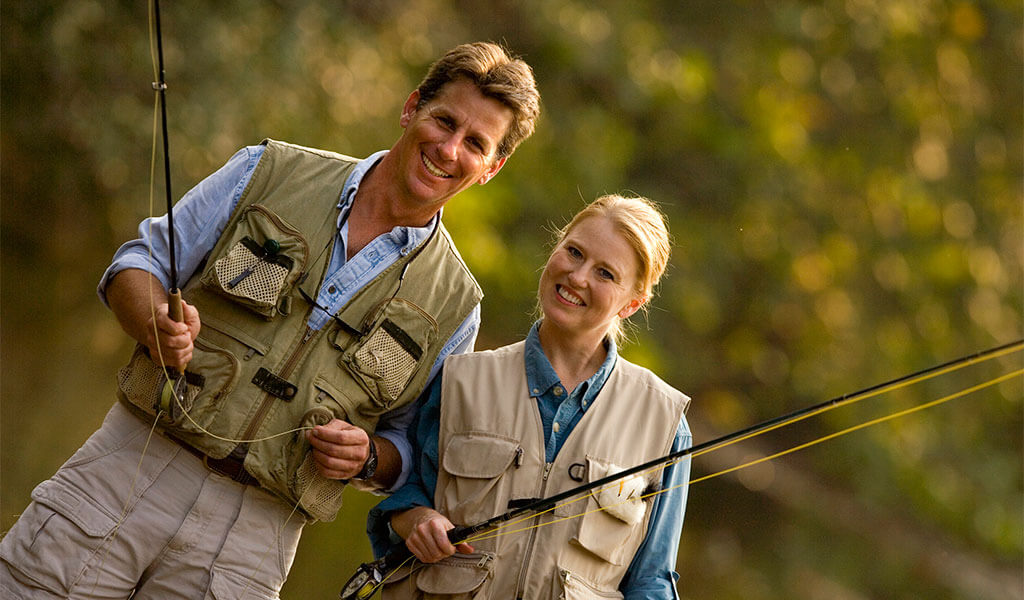
Nestled in the oak-studded Sierra foothills on the western edge of Mariposa County, sun-soaked Lake McClure and its little brother Lake McSwain are the way station for the Wild & Scenic Merced River as it journeys towards the Central Valley. The regularly stocked lakes offer trophy-level fishing, family camping, water sports, house boating and even hang gliding.
Lake McClure Fishing
Situated at 867 feet, horseshoe-shaped Lake McClure features 80 miles of shoreline with wide, deep sections as well as inlets and secluded coves. With approaches from shore or by boat, the catch includes rainbow, brown and brook trout; kokanee salmon; largemouth and spotted bass; crappie, bluegill, shad and catfish.
Lake McSwain Fishing
Located six miles below the dam at Lake McClure, Lake McSwain has consistent water levels and is known for its trout (rainbow, brown and brook). The 10 mph speed limit ensures calm waters making for great kayaking with the kiddos. Held in late spring, the Lake McSwain Trout Fishing Derby provides the opportunity for skilled (lucky?) anglers to win cash prizes by hauling in one (or more!) of the specially tagged fish. Fun fact: the largest rainbow trout ever caught out of Lake McSwain was 17.5 lbs. and 34 inches long.
Outfitters & Local Fishing Guides
Echo Adventure Cooperative: a guide-owned cooperative, the EAC offers socially and environmentally sustainable adventures in Yosemite and surrounding areas including private, catch & release fly fishing for trout in the Tuolumne and Merced River watersheds.
Yosemite Fly Fishing Guide: With its private, customized fly fishing trips inside Yosemite for all ages & experience levels, YFFG teaches the fundamentals of casting and reading the water as well as providing transportation from lodges, hotels or pre-determined pickup locations.
Yosemite Outfitters: passionate about hiking Yosemite’s majestic forests and fishing the local water, Yosemite Outfitters offers trips along the Tuolumne and Merced Rivers including their Walk & Wade trips and Fishy Kids program, a hands-on introduction to fish anatomy, aquatic insects and the world of fly fishing.
Sierra Fly Fisher: Running trips in Yosemite, King’s Canyon and beyond, Sierra Fly Fisher offers guided trips, instruction and camps in California’s Sierra Nevada.
Pro Tips
- For everything from up-to-date rules to fish identification, try the California Freshwater Sportfishing Regulations
- Check out the California Department of Fish & Wildlife (CDFW) for information on sport fishing licenses (required for all anglers 16 and older).
- Be sure to follow fishing regulations for Yosemite National Park, which are additional to the state of California regulations.
- For a dynamic, mappable, county-by-county list check the CDFW’s fish planting schedule.
- Take a foodie tour with our complete guide on where to eat in Yosemite Mariposa, including to-go foods for fishing adventures off-the-beaten-path.
- For everything from dispersed camping to world-class resorts, check out where to stay in Yosemite Mariposa.

